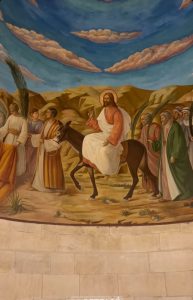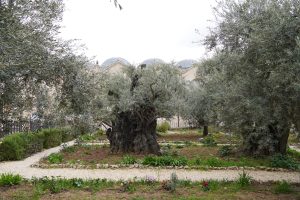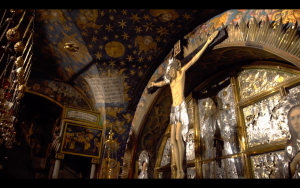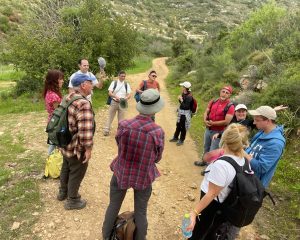Holy Week begins once again, in many countries, these are public holidays marked by religious celebrations. But why? What is Holy Week? Why is it celebrated? What is its meaning?

Jerusalem
Holy Week recalls events that truly happened here, in Jerusalem, in specific places; events which, in a unique and extraordinary way, broke through the barrier of time and entered human history forever: for 2,000 years, the passion, death, and resurrection of Jesus have challenged the world, generation after generation. The celebrations of these days begin with the solemnity of Palm Sunday. Here, people from all over the world, in a festive atmosphere shared with the local community, relive Jesus’ triumphal entry into Jerusalem, riding a humble donkey.

Bethphage, Jerusalem
From Bethphage, just a few kilometers from the city, the procession moves forward with songs and dances in a singular and unique Holy Week parade. It passes in front of the Church of the Pater Noster, where the Lord’s Prayer that Jesus taught us is written in every language; it descends toward Gethsemane, through the Mount of Olives, leaving on its right hand side the Dominus Flevit Church, from which one can see the entire city of Jerusalem — over which Jesus wept, knowing it would be destroyed a few years after his death. Finally, it enters the walled city through the Lions’ Gate, arriving at the present-day Church of Saint Anne, the maternal grandmother of Jesus. There, the faithful are blessed by the Latin Patriarch of Jerusalem, Cardinal Pierbattista Pizzabala, using a relic of the True Cross.
On Holy Thursday here, at the Holy Sepulcher, just a few meters from the Cenacle – where Jesus, on the eve of his freely accepted Passion, shared the Passover meal with his disciples – takes place the celebration of the memorial that makes present anew the institution of the Eucharist and Jesus’ command, “do this in memory of me,” which lies at the origin of the Christian priesthood.

The Cenacle, Jerusalem
From Gethsemane, at night, in the olive garden, after a prayer here, before the rock where Jesus prayed, sweating blood, a silent, torchlit procession sets out, crossing the Kidron Valley and ending at Gallicantu.

Gethsemane, Mount of Olives
Here, at Gallicantu, a church built over the ruins of the high priest’s home – in which he questioned Jesus about his identity and mission – the denial by Peter, disowning three times his teacher and friend, is also recalled. It fulfilled the prophecy Jesus had made to him: “before the cock crows at dawn, you will deny me three times.” Excavations allow access to a dungeon where Jesus was held prisoner all night. To the left of the present-day church, very ancient stairs bridge the grading between the lower and upper parts of the city at that spot. Here, many Christians spend the night in prayer, with the city of Jerusalem in the background.
Good Friday is here, on Calvary, where Jesus’ death on the cross is commemorated.

Chapel of Calvary, Jerusalem
Just a few meters away, within the same complex, is the Tomb, the Holy Sepulcher, where Jesus was laid and where “on the third day he rose again”—a unique, singular, and extraordinary event that marks the beginning of the spread of the Christian message throughout the world. Jesus, the Son of God, triumphs over death.
Once again here, in the Cenacle, the disciples, fearful and in shock from the events of those days, received the astonishing news of Jesus’ resurrection, just as He had foretold.
And here, on the road to Emmaus—possibly at the height of Saxum? —he met two disciples, who recovered their joy as he explained the Scriptures to them, and who then recognized him in the breaking of the bread: “Stay with us, for it is nearly evening” (Luke 24:13-35).
By Carmen Rodríguez Eyre

The Way to Emmaus
